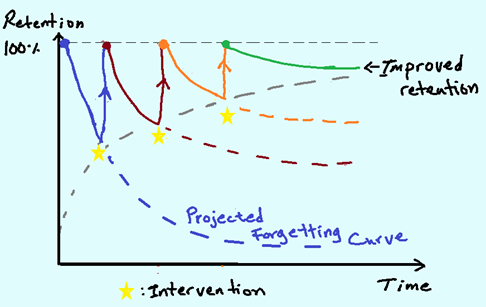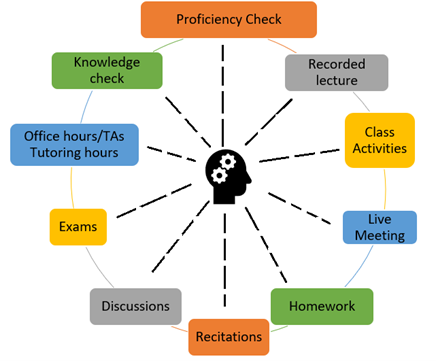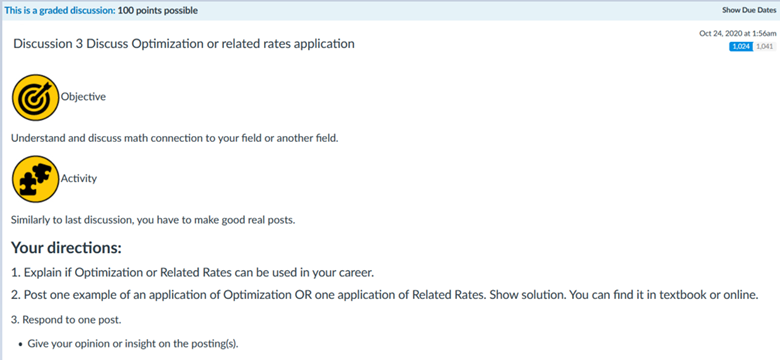Tags: Instructional Model, Interaction, Peer-Reviewed Entry, Process, STEM

Description
Instructors frequently depend on high stake assessments such as final exams to evaluate students’ knowledge at the end of courses. Those assessments could be timed and comprehensive. A reality that worries several students because high stake assignments can affect greatly their grades at the end of a semester if they do not perform as anticipated. Moreover, instructors often see that students do not remember key concepts from prerequisite courses. This could be due to students’ study habits of cramming information right before the examinations. Hence, what can instructors do to alleviate all those, so called, challenges?
A recurrent question that is necessary to be unraveled now is that the COVID-19 pandemic has made the condition worse. In March 2020, most universities went into remote teaching mode and the instructors had to suddenly change from face-to-face instruction to remote instruction. It was difficult to do with a sudden closure of campuses, and they needed to make major rearrangements in teaching strategies and assessments (Maalem et al., 2020). They also had to think outside the standard boxes to generate various possible solutions (Hodges et al., 2020). In this article, we examine modeling and promoting “spaced repetition”, known also as “spaced practice”, as a key strategy to support long term retention of materials learnt.
Strategy: Spaced Repetition
Spaced repetition started with Ebbinghaus’s famous experiment of forgetting curve (1880-1885), when Ebbinghaus’ goal was to find a legitimate relation between memory retention and time-since-learning (Murre & Dros, 2015). Understandably, retention varies inversely with time, meaning memories decay with elapsed time (Subirana et al., 2017). Hence, an intervention is needed to bring it back to prior state. The more interventions the better. Those interventions are space repetitions, and they can be in form of reinforcement, or reviews, or discussions or reflections. The idea is depicted in figure 1 below:

Research reported benefits of spaced repetition (Voice & Stirton, 2020), has been widely used in both medical and law education (Teninbaum, 2017). Consequently, the purpose here is to take advantage of it in the designing of mathematics courses at the University of Central Florida, Orlando. We recognize that many of our students may not know how to study, they may not know how memorization and learning work. Large majority of our students often struggle with time management and balancing school with work, or other personal factors. We present our observations and thoughts one by one.
Link to scholarly artifact(s)
Artifact One
The example which we use in this paper is “Calculus with Analytic Geometry I (Calculus I)” course. The instructor usually has a brief chance in each lecture to cover a topic and move on to the next one. As a result, a common path for the student is to see the content during the lecture, practice applications by solving homework problems, and study for midterm and Final. Probably most of them will not revisit what they study for a test until they study for the final examination. This approach to learning affects retention; for example, retention decreases greatly when a student uses cramming to study for examinations (forgetting curve in Figure 1). As far as Calculus I is concerned, the topics that the students who pass the course may not remember well are the “chain rule”, “related rates”, “method of curve sketching”, “optimization problems”, and “integration by substitution”. The experimented redesign based on spaced repetition is shown in Figure 2.

In the proposed approach, different interventions are arranged, and the weighted grading system is adjusted to emphasize all categories. For instance, the percentage value of a grade item (or a single assignment) cannot be 20% (or more) of the final grade. In other words, it becomes tricky to point out to a single assignment as a high-stake assignment.
This course is taught via distance learning with adoption of both synchronous and asynchronous modes during the pandemic. Proficiency check is a diagnostic assessment that allows us to evaluate students’ prior knowledge and give them feedback on what they need to review; and it is helpful for the instructor to know which topics to include in “just in time reviews”. Recorded lecture, discussions, recitation activities are asynchronously delivered via Learning Management System (LMS) and give students the benefit of listening to a well- prepared talk. Live meetings during assigned class times, assigned recitation (small groups) meetings, and scheduled office hours are synchronous. They are delivered via Zoom. They help to build a learning community in the course.
Artifact Two
To improve retention several ideas can be discussed, for example, rearranging topics to allow for spaced repetition. Instructor’s expertise is helpful to not depend on the textbook sequence and manage topics so that there is a chance for many important concepts to be practiced several times. This artifact is selected because it is not commonly used in mathematics courses that meet live to integrate asynchronous “discussions” in LMS. When this is used some students may complain about having to do research and write discussion posts. Hence, it is helpful to provide a rationale for using the discussions. They are delivered in LMS, and students are encouraged to participate early. They must submit their work before seeing an existing post. After reading the posts of classmates they choose to reply to a classmate’s contribution. A rubric is provided to make the assignment grading uniform and transparent. An example of a discussion is shown in Figure 3. It is about related rates and optimization topics that are identified to be the most challenging topics for students to remember after completing the course. Hence, this discussion is one of the interventions that are planned in the course redesign.

Impact
As discussed in Artifact 2, it is essential to provide rationale which is the justifying reason behind the distributed practice, and it should be accounted for as an integral part of instruction (CSUN Undergraduate Studies, 2021). Without rationale, students’ perception to distributed practice may not be same as ours because they are not the ones who set up the course. It is important not to assume that multiple assignments are spaced repetition if they were not planned for that purpose. That is why writing rationale while designing the course helps in identifying how those assignments are linked and work together.
This strategy was in implemented during fall 2020 by the authors. Overall, results show an increase of success rate, and a better student-engagement. Students’ perceptions were positive in the end of the course surveys; for example, one student wrote when asked about what they liked best about the course: “Homework and discussions were helpful to understand the topics.” Another student wrote when asked about suggestions to improve the course: “One suggestion would be to integrate more discussions about the various applications of certain concepts. For example, more questions related to engineering, medicine, etc. are needed to reinforce the important applications of concepts in calculus.” Hence, with careful planning, spaced repetition can also support relevance of the topics.
An encouraging result from this research is that students showed better self-efficacy in multiple submissions. Furthermore, when they were asked if they were confident in talking about calculus in public. From the 238 students who responded to an anonymous survey delivered in LMS, 200 respondents or 84% agreed, 37 respondents or 16% disagreed, and 1 respondent chose not to answer. The 84% is a remarkable number of students and provides an encouraging result to practice further.
Link to scholarly reference(s)
CSUN Undergraduate Studies (2021). Teach with transparency. https://canvas.csun.edu/courses/93131/pages/transparent-assignments
Enterprises, S. (2005). How to write a How to Write a. International Journal of Pediatric Otorhinolaryngology, 18(3), 118–119. http://dx.doi.org/10.1016/j.tics.2013.12.008
Hodges, C., Moore, S., Lockee, B., Trust, T., & Bond, A. (2020). The Difference between emergency remote teaching and online learning. EDUCAUSE Review. https://er.educause.edu/articles/2020/3/the-difference-between-emergency-remote-teaching-and-online-learning
Murre, J. M. J., & Dros, J. (2015). Replication and analysis of Ebbinghaus’ forgetting curve. PLoS ONE, 10(7), 1–24. https://doi.org/10.1371/journal.pone.0120644
Rachid, A. M. L., Mohapatra, R., & Chen, B. (2020). Prioritizing strategies for a better transition to remote instruction strategy. https://er.educause.edu/articles/2020/11/prioritizing-strategies-for-a-better-transition-to-remote-instruction
Subirana, B., Bagiati, A., & Sarma, S. (2017). On the forgetting of college academics: At “Ebbinghaus Speed”? EDULEARN17 Proceedings, 1(068), 8908–8918. https://doi.org/10.21125/edulearn.2017.0672
Teninbaum, G. H. (2017). Spaced repetition: A Method for learning more law in less time. The Journal of High Technology Law, 17(2), 273.
Voice, A., & Stirton, A. (2020). Spaced repetition: Towards more effective learning in STEM. New Directions in the Teaching of Physical Sciences, 15(15), 1–10. https://doi.org/10.29311/ndtps.v0i15.3376
Citation
Lahcen. R., & Mohapatra, R. (2021). Modeling spaced repetition in course design. In A. deNoyelles, A. Albrecht, S. Bauer, & S. Wyatt (Eds.), Teaching Online Pedagogical Repository. Orlando, FL: University of Central Florida Center for Distributed Learning. https://topr.online.ucf.edu/modeling-spaced-repetition-in-course-design/.Post Revisions:
This post has not been revised since publication.

